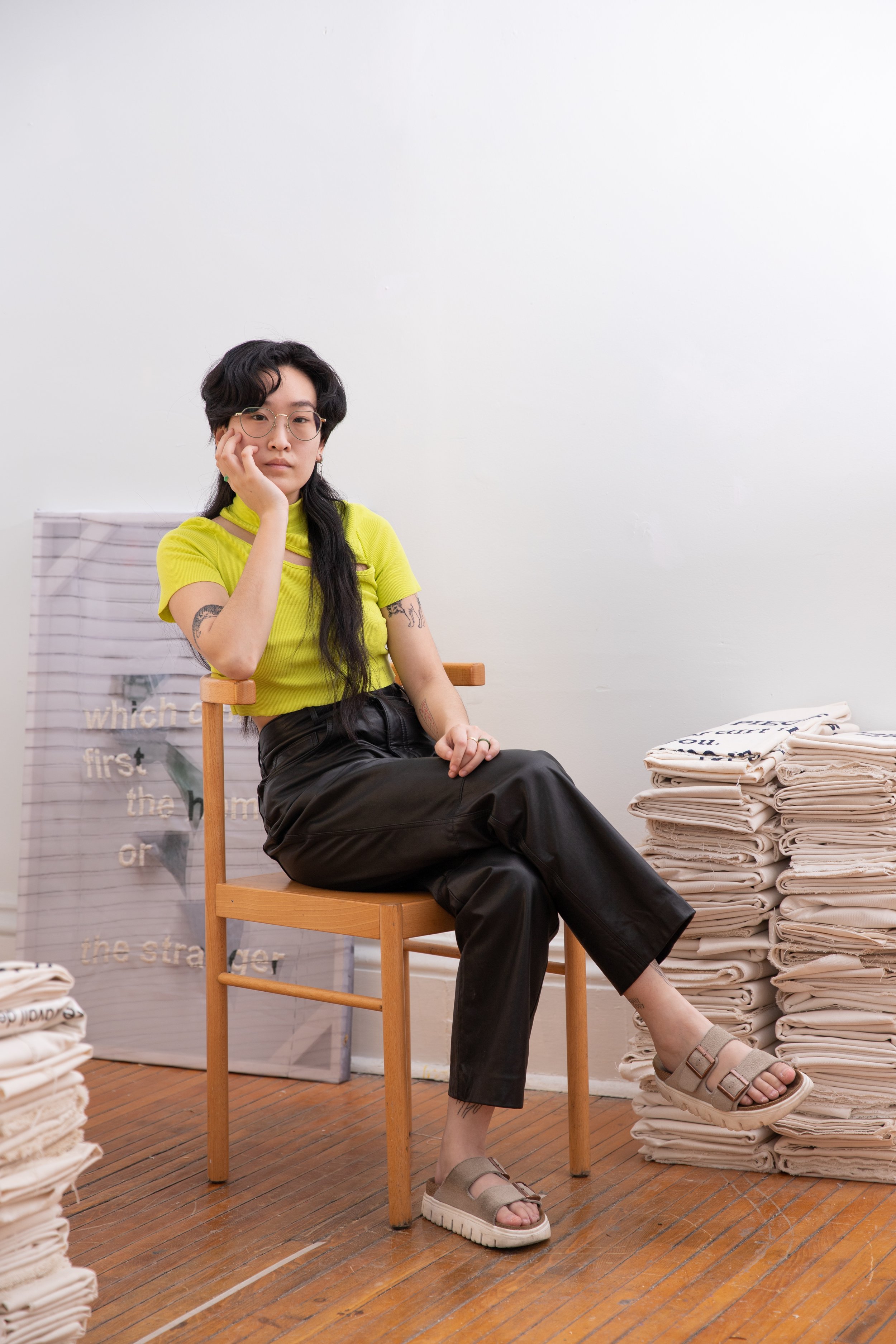Photo by Ananna Rafa and Jenn Qu
Lan “Florence” Yee 余承佳 is a visual artist and cultural worker based in Tkaronto/Toronto & Tiohtià:ke/Mooniyang/Montreal. They collect text in underappreciated places and ferment it until it is too suspicious to ignore. Lan’s work has been exhibited at the Art Museum at The University of Toronto (2024), the Textile Museum of Canada (2023-24), the Darling Foundry (2022), the Toronto Museum of Contemporary Art (2021), and the Gardiner Museum (2019), among others. They obtained a BFA from Concordia University and an MFA from OCAD U as a Joseph-Armand Bombardier SSHRC scholar. They are a recipient of the William and Meredith Saunderson Prizes for Emerging Artists (2023). Lan writes and curates as a member of JIA Foundation, fostering Chinatown’s cultural heritage.
Lan’s artwork is represented by Zalucky Contemporary.
CV // Contact: lan.they.them@gmail.com
Lan « Florence » Yee 余承佳 est un·e artiste visuel·le et un·e travailleur·se culturel·le basé·e à Tkaronto/Toronto et Tiohtià:ke/Mooniyang/Montréal. Il recueille des textes parmi des endroits peu appréciés et les fait fermenter jusqu’à ce qu’ils soient trop suspects pour être ignorés. Les œuvres de Lan ont été exposées au Musée d'art de l'Université de Toronto (2024), au Musée du textile du Canada (2023-24), à la Fonderie Darling (2022), au Musée d'art contemporain de Toronto (2021) et au Musée Gardiner (2019), entre autres. Il a obtenu un baccalauréat en beaux-arts de l'Université Concordia et une maîtrise en beaux-arts de OCAD U en tant que boursier Joseph-Armand Bombardier du CRSH. Il est lauréat·e du prix William et Meredith Saunderson pour artistes émergents (2023). Lan écrit et organise des expositions en tant que membre de la Fondation JIA, qui promeut le patrimoine culturel du Quartier chinois.
Les œuvres de Lan sont représentées par Zalucky Contemporary.
Artist Statement
My interdisciplinary practice draws on writing and unassuming imagery to permeate the slippery ends of meaning. Through a wide range of media, including oil painting, textile embroidery, sculptural installation, electronic signage, and photography, each are grounded together by unearthing speculative bonds between the historical and personal.
My text-based artwork borrows the anonymous pen of templates, signage, and forms, while displacing their functions through skeptical experiences. The often ironic and humorous tones in the language recognize the limits of their own structure, and sustain a necessary uncertainty. The intimacy of this doubt gives me the space to interrogate the echoes that make up queer diasporic memory. Rather than looking at the height of grand moments, I prefer to investigate their systemic origins, and what continues to leak in the aftermath.
The slower methods of creation make way for a process that uses time and materials to “work through” the restrictive belonging we may seek from language, duty, and (re)presentation. As “hard work” is a main measurement from which racialized & migrant bodies are valued, my practice uses the double-edged sword of visibility and recognition to explore how we may queer desirability. It attempts to step around easy signifiers of legibility with sparse retellings, obscured patterns, and frequent interruptions. Away from the flattening effect of nostalgia, I seek to deromanticize linear narratives of intergenerational knowledge by showcasing repetition and dead ends.
______
Ma pratique interdisciplinaire s'appuie sur l'écriture et des images ordinaires pour explorer les limites insaisissables du sens. À travers un large éventail de médias, notamment la peinture à l'huile, la broderie textile, les installations sculpturales, la signalétique électronique et la photographie, chacune est reliée ensemble en exhumant les liens spéculatifs entre l'historique et le personnel.
Mes œuvres textuelles empruntent la plume anonyme des échantillons, des panneaux et des formulaires, tout en déplaçant leurs fonctions à travers des expériences sceptiques. Les tons souvent ironiques et humoristiques du langage reconnaissent les limites de leur propre structure et maintiennent une incertitude nécessaire. L'intimité de ce doute me donne l'espace pour interroger les échos constituant la mémoire diasporique queer. Plutôt que de me lancer vers les moments décisifs de l'histoire, je me concentre sur les moments de doute et de questionnement. Les tons souvent ironiques et humoristiques du langage reconnaissent les limites de leur propre structure et maintiennent une incertitude nécessaire. L'intimité de ce doute me donne l'espace nécessaire pour interroger les échos qui composent la mémoire diasporique queer. Plutôt que de me concentrer sur l'apogée des grands moments, je préfère enquêter sur leurs origines systémiques et sur ce qui continue de s'échapper après coup.
Les méthodes de création plus lentes ouvrent la voie à un processus qui utilise le temps et les matériaux pour réviser l'appartenance restrictive que nous pouvons rechercher dans le langage, le devoir et la (re)présentation. Comme le « travail acharné » est l'un des principaux critères d'évaluation des corps racialisés et migrants, ma pratique utilise l'arme à double tranchant de la visibilité et de la reconnaissance pour chercher comment nous pouvons rendre queer la désirabilité. Elle tente de contourner les signifiants faciles de lisibilité par des récits clairsemés, des motifs obscurs et des interruptions fréquentes. Loin de l'effet aplatissant de la nostalgie, je cherche à déromantiser les récits linéaires du savoir intergénérationnel en mettant en évidence les répétitions et les impasses.
Lan would like to acknowledge the support of the Canada Council for the Arts, the Ontario Arts Council, and the Toronto Arts Council.





